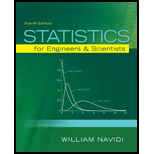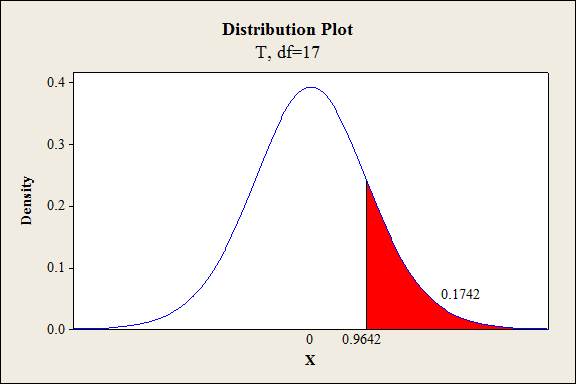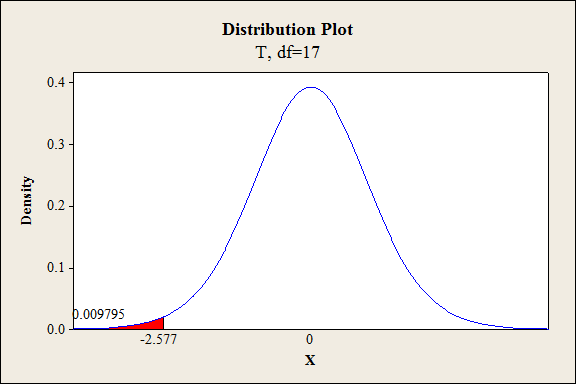
Concept explainers
a.
Find the 95% confidence interval for the slope of Manganese.
a.
Answer to Problem 2E
The 95% confidence interval for the slope of Manganese is
Explanation of Solution
Given info:
The data represents the MINITAB output of the regression model
Calculation:
Multiple linear regression model:
A multiple linear regression model is given as
The ‘Coefficient’ column of the regression analysis MINITAB output gives the slopes corresponding to the respective variables stored in the column ‘Predictor’.
Let
From the accompanying MINITAB output, the slope coefficient of Manganese is
Confidence interval:
The general formula for the confidence interval for the slope of the regression line is,
Where,
From the accompanying MINITAB output, the estimate of error standard deviation of slope coefficient of Manganese is
Critical value:
For 95% confidence level,
Degrees of freedom:
The number of plates that are sampled is
The degrees of freedom is,
From Table A.5 of the t- distribution in Appendix A, the critical value corresponding to the right tail area 0.025 and 17 degrees of freedom is 2.110.
Thus, the critical value is
The 95% confidence interval is,
Thus, the 95% confidence interval for the slope of Manganese is
Interpretation:
There is 95% confident that the average change in the tensile strength associated with 1 ppt increase in manganese lies between
b.
Find the 99% confidence interval for the slope of Thickness.
b.
Answer to Problem 2E
The 99% confidence interval for the slope of Thickness is
Explanation of Solution
Calculation:
From the accompanying MINITAB output, the slope coefficient of Thickness is
Confidence interval:
The general formula for the confidence interval for the slope of the regression line is,
Where,
From the accompanying MINITAB output, the estimate of error standard deviation of slope coefficient of Thickness is
Critical value:
For 99% confidence level,
Degrees of freedom:
The number of plates that are sampled is
The degrees of freedom is,
From Table A.5 of the t- distribution in Appendix A, the critical value corresponding to the right tail area 0.005 and 17 degrees of freedom is 2.898.
Thus, the critical value is
The 95% confidence interval is,
Thus, the 99% confidence interval for the slope of Thickness is
Interpretation:
There is 99% confident that the average change in the tensile strength associated with 1 ppt increase in Thickness lies between
c.
Test whether there is enough evidence to conclude that
c.
Answer to Problem 2E
There is no sufficient evidence to conclude that
Explanation of Solution
Calculation:
From the accompanying MINITAB output, the slope coefficient of Manganese is
Here, the claim is that
The test hypotheses are given below:
Null hypothesis:
That is, 1 ppt increase in manganese tends to at most
Alternative hypothesis:
That is, increase in the true average of tensile strength due to 1 ppt increase in manganese will be greater than
Test statistic:
The test statistic is,
Where,
From the accompanying MINITAB output, the estimate of error standard deviation of slope coefficient of Manganese is
Test statistic under null hypothesis:
Under the null hypothesis, the test statistic is obtained as follows:
Thus, the test statistic is 0.9642.
Degrees of freedom:
The number of plates that are sampled is
The degrees of freedom is,
Thus, the degree of freedom is 17.
Here, level of significance is not given.
So, the prior level of significance
P-value:
Software procedure:
Step by step procedure to obtain the P- value using the MINITAB software:
- Choose Graph > Probability Distribution Plot choose View Probability > OK.
- From Distribution, choose ‘t’ distribution and enter 17 as degrees of freedom.
- Click the Shaded Area tab.
- Choose X-Value and Right Tail for the region of the curve to shade.
- Enter the X-value as 0.9642.
- Click OK.
Output obtained from MINITAB is given below:

From the output, the P- value is 0.1742.
Thus, the P- value is 0.1742.
Decision criteria based on P-value approach:
If
If
Conclusion:
The P-value is 0.1742 and
Here, P-value is greater than the
That is
By the rejection rule, fail to reject the null hypothesis.
Hence, 1 ppt increase in manganese tends to at most
Therefore, there is no sufficient evidence to conclude that
d.
Test whether there is enough evidence to conclude that
d.
Answer to Problem 2E
There is sufficient evidence to conclude that
Explanation of Solution
Calculation:
From the accompanying MINITAB output, the slope coefficient of Thickness is
Here, the claim is that
The test hypotheses are given below:
Null hypothesis:
That is, 1 mm increase in thickness tends to at least
Alternative hypothesis:
That is, decrease in the true average of tensile strength due to 1 mm increase in thickness will be less than
Test statistic:
The test statistic is,
Where,
From the accompanying MINITAB output, the estimate of error standard deviation of slope coefficient of Thickness is
Test statistic under null hypothesis:
Under the null hypothesis, the test statistic is obtained as follows:
Thus, the test statistic is -2.577.
Degrees of freedom:
The number of plates that are sampled is
The degrees of freedom is,
Thus, the degree of freedom is 17.
Here, level of significance is not given.
So, the prior level of significance
P-value:
Software procedure:
Step by step procedure to obtain the P- value using the MINITAB software:
- Choose Graph > Probability Distribution Plot choose View Probability > OK.
- From Distribution, choose ‘t’ distribution and enter 17 as degrees of freedom.
- Click the Shaded Area tab.
- Choose X-Value and Left Tail for the region of the curve to shade.
- Enter the X-value as -2.577.
- Click OK.
Output obtained from MINITAB is given below:

From the output, the P- value is 0.009795.
Thus, the P- value is 0.009795.
Decision criteria based on P-value approach:
If
If
Conclusion:
The P-value is 0.009795 and
Here, P-value is less than the
That is
By the rejection rule, reject the null hypothesis.
Hence, 1 mm increase in thickness tends to at least
Therefore, there is sufficient evidence to conclude that
Want to see more full solutions like this?
Chapter 8 Solutions
Statistics for Engineers and Scientists (Looseleaf)
- This problem is based on the fundamental option pricing formula for the continuous-time model developed in class, namely the value at time 0 of an option with maturity T and payoff F is given by: We consider the two options below: Fo= -rT = e Eq[F]. 1 A. An option with which you must buy a share of stock at expiration T = 1 for strike price K = So. B. An option with which you must buy a share of stock at expiration T = 1 for strike price K given by T K = T St dt. (Note that both options can have negative payoffs.) We use the continuous-time Black- Scholes model to price these options. Assume that the interest rate on the money market is r. (a) Using the fundamental option pricing formula, find the price of option A. (Hint: use the martingale properties developed in the lectures for the stock price process in order to calculate the expectations.) (b) Using the fundamental option pricing formula, find the price of option B. (c) Assuming the interest rate is very small (r ~0), use Taylor…arrow_forwardDiscuss and explain in the picturearrow_forwardBob and Teresa each collect their own samples to test the same hypothesis. Bob’s p-value turns out to be 0.05, and Teresa’s turns out to be 0.01. Why don’t Bob and Teresa get the same p-values? Who has stronger evidence against the null hypothesis: Bob or Teresa?arrow_forward
- Review a classmate's Main Post. 1. State if you agree or disagree with the choices made for additional analysis that can be done beyond the frequency table. 2. Choose a measure of central tendency (mean, median, mode) that you would like to compute with the data beyond the frequency table. Complete either a or b below. a. Explain how that analysis can help you understand the data better. b. If you are currently unable to do that analysis, what do you think you could do to make it possible? If you do not think you can do anything, explain why it is not possible.arrow_forward0|0|0|0 - Consider the time series X₁ and Y₁ = (I – B)² (I – B³)Xt. What transformations were performed on Xt to obtain Yt? seasonal difference of order 2 simple difference of order 5 seasonal difference of order 1 seasonal difference of order 5 simple difference of order 2arrow_forwardCalculate the 90% confidence interval for the population mean difference using the data in the attached image. I need to see where I went wrong.arrow_forward
- Microsoft Excel snapshot for random sampling: Also note the formula used for the last column 02 x✓ fx =INDEX(5852:58551, RANK(C2, $C$2:$C$51)) A B 1 No. States 2 1 ALABAMA Rand No. 0.925957526 3 2 ALASKA 0.372999976 4 3 ARIZONA 0.941323044 5 4 ARKANSAS 0.071266381 Random Sample CALIFORNIA NORTH CAROLINA ARKANSAS WASHINGTON G7 Microsoft Excel snapshot for systematic sampling: xfx INDEX(SD52:50551, F7) A B E F G 1 No. States Rand No. Random Sample population 50 2 1 ALABAMA 0.5296685 NEW HAMPSHIRE sample 10 3 2 ALASKA 0.4493186 OKLAHOMA k 5 4 3 ARIZONA 0.707914 KANSAS 5 4 ARKANSAS 0.4831379 NORTH DAKOTA 6 5 CALIFORNIA 0.7277162 INDIANA Random Sample Sample Name 7 6 COLORADO 0.5865002 MISSISSIPPI 8 7:ONNECTICU 0.7640596 ILLINOIS 9 8 DELAWARE 0.5783029 MISSOURI 525 10 15 INDIANA MARYLAND COLORADOarrow_forwardSuppose the Internal Revenue Service reported that the mean tax refund for the year 2022 was $3401. Assume the standard deviation is $82.5 and that the amounts refunded follow a normal probability distribution. Solve the following three parts? (For the answer to question 14, 15, and 16, start with making a bell curve. Identify on the bell curve where is mean, X, and area(s) to be determined. 1.What percent of the refunds are more than $3,500? 2. What percent of the refunds are more than $3500 but less than $3579? 3. What percent of the refunds are more than $3325 but less than $3579?arrow_forwardA normal distribution has a mean of 50 and a standard deviation of 4. Solve the following three parts? 1. Compute the probability of a value between 44.0 and 55.0. (The question requires finding probability value between 44 and 55. Solve it in 3 steps. In the first step, use the above formula and x = 44, calculate probability value. In the second step repeat the first step with the only difference that x=55. In the third step, subtract the answer of the first part from the answer of the second part.) 2. Compute the probability of a value greater than 55.0. Use the same formula, x=55 and subtract the answer from 1. 3. Compute the probability of a value between 52.0 and 55.0. (The question requires finding probability value between 52 and 55. Solve it in 3 steps. In the first step, use the above formula and x = 52, calculate probability value. In the second step repeat the first step with the only difference that x=55. In the third step, subtract the answer of the first part from the…arrow_forward
- If a uniform distribution is defined over the interval from 6 to 10, then answer the followings: What is the mean of this uniform distribution? Show that the probability of any value between 6 and 10 is equal to 1.0 Find the probability of a value more than 7. Find the probability of a value between 7 and 9. The closing price of Schnur Sporting Goods Inc. common stock is uniformly distributed between $20 and $30 per share. What is the probability that the stock price will be: More than $27? Less than or equal to $24? The April rainfall in Flagstaff, Arizona, follows a uniform distribution between 0.5 and 3.00 inches. What is the mean amount of rainfall for the month? What is the probability of less than an inch of rain for the month? What is the probability of exactly 1.00 inch of rain? What is the probability of more than 1.50 inches of rain for the month? The best way to solve this problem is begin by a step by step creating a chart. Clearly mark the range, identifying the…arrow_forwardClient 1 Weight before diet (pounds) Weight after diet (pounds) 128 120 2 131 123 3 140 141 4 178 170 5 121 118 6 136 136 7 118 121 8 136 127arrow_forwardClient 1 Weight before diet (pounds) Weight after diet (pounds) 128 120 2 131 123 3 140 141 4 178 170 5 121 118 6 136 136 7 118 121 8 136 127 a) Determine the mean change in patient weight from before to after the diet (after – before). What is the 95% confidence interval of this mean difference?arrow_forward
 Glencoe Algebra 1, Student Edition, 9780079039897...AlgebraISBN:9780079039897Author:CarterPublisher:McGraw Hill
Glencoe Algebra 1, Student Edition, 9780079039897...AlgebraISBN:9780079039897Author:CarterPublisher:McGraw Hill Big Ideas Math A Bridge To Success Algebra 1: Stu...AlgebraISBN:9781680331141Author:HOUGHTON MIFFLIN HARCOURTPublisher:Houghton Mifflin Harcourt
Big Ideas Math A Bridge To Success Algebra 1: Stu...AlgebraISBN:9781680331141Author:HOUGHTON MIFFLIN HARCOURTPublisher:Houghton Mifflin Harcourt Holt Mcdougal Larson Pre-algebra: Student Edition...AlgebraISBN:9780547587776Author:HOLT MCDOUGALPublisher:HOLT MCDOUGAL
Holt Mcdougal Larson Pre-algebra: Student Edition...AlgebraISBN:9780547587776Author:HOLT MCDOUGALPublisher:HOLT MCDOUGAL



